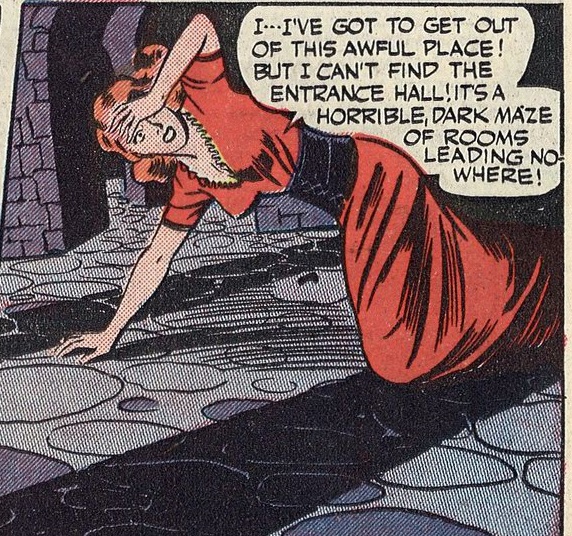Project started August 2023.
Books and articles
Asma, Stephen T. On monsters: An unnatural history of our worst fears. Oxford University Press, 2011. – Not very useful for this project.
Brown, Sherri L., Carol A. Senf, and Ellen Justine Stockstill. A Research Guide to Gothic Literature in English : Print and Electronic Sources. Lanham, Maryland: Rowman & Littlefield, 2018. – Terrific resource. Helped me identify lots of resources for research.
Byron, Glennis, and Dale Townshend, eds. The Gothic World. London ; Routledge, 2014. – I need to check this out again. Rich resource.
Carriger, Gail. The Heroine’s Journey: For Writers, Readers, and Fans of Pop Culture. USA: Gail Carriger LLC, 2020. – This is the book that really got me thinking about work produced specifically for female audiences. (This will turn out to be one of the major threads of this project – I am haunted by misogyny in ways I still don’t/barely recognize.)
Clery E. J. 1999. The Rise of Supernatural Fiction 1762-1800 1St pbk. ed. Cambridge: Cambridge University Press. – Roughly covers gothic literature but through the lens of the supernatural instead of Gothic.
Chandrasekera, Vajra. “Walpolitics.” January 25, 2024. https://vajra.me/2024/01/25/walpolitics/ – interesting take on the term “serendipity” coined by Horace Walpole.
Copley, Stephen, and John Whale, eds. Beyond Romanticism: New Approaches to Texts and Contexts 1780-1832. Routledge, 2016. – collection of essays. Mostly interested in “The wanton muse : politics and gender in Gothic theory after 1760” by Harriet Guest, which I read but don’t remember.
Fothergill, Brian. The Strawberry Hill Set: Horace Walpole and His Circle. Faber & Faber, 2013. – Looks at Walpole’s circle of friends. Divides Walpole’s circle of friendships – strawberry, politics, literature, schoolhood friends, antiquaries, last years. Mostly off-topic for this project. Somewhat useful description of Walpole’s friendship with Thomas Gray.
Gaunt, Peter. Oliver Cromwell. Vol. 5. NYU Press, 2004. – Brief sketch of Cromwell’s life. Read for background.
Gordon, Charlotte. Romantic Outlaws : The Extraordinary Lives of Mary Wollstonecraft and Her Daughter Mary Shelley. First U.S. edition. New York: Random House, 2015. – Excellent book. Interesting parallel structure. Well written. The structure might be problematic on a scholarly/academic level, but definitely an enjoyable read.
Hoeveler, Diane Long. Gothic feminism: the professionalization of gender from Charlotte Smith to the Brontës. Penn State Press, 1998. – Great book. Hoeveler is key scholar. Need to reread this after a few months of research.
Modleski Tania. 19841982. Loving with a Vengeance : Mass-Produced Fantasies for Women. New York: Methuen. – Early critical analysis of Harlequin Romance. Also a section on Gothic Romance and a chapter on soap operas. Notable for being a serious look at mass pop culture created for female consumption. Overly Freudian analysis. Draws some good points from Joanna Russ. Explains the formula of Harlequin (the scoundrel is not a scoundrel).
Mowl, Timothy. Horace Walpole: the great outsider. Faber & Faber, 2014. – Deserves credit for bluntly addressing Walpole’s gender/sexual identity instead of ignoring it or referring to it only obliquely. However, Mowl is not a particularly sophisticated gender historian.
Paige, Lori A. The Gothic Romance Wave: A Critical History of the Mass Market Novels, 1960-1993. McFarland, 2018. – Weak. A few good references. More a defense of mass market gothic romance than a critical analysis. Often contradictory.
Reeve, Matthew M. Gothic architecture and sexuality in the circle of Horace Walpole. Penn State Press, 2020. – Focuses on architecture instead of literature. Wonderful work. Just a really great book. Terrific bibliography. Great collection of images. Pretty nuanced and comprehensive. This book bears returning to toward the end of this research project. Read in January of 2024.
Russ, Joanna. “On Mary Wollstonecraft Shelley.” To write like a woman: essays in feminism and science fiction. Indiana University Press, 1995. – Not good. Russ doesn’t have a good grasp of Shelley’s work, history, and context.
Russ, Joanna. “Somebody’s Trying to Kill Me and I Think It’s My Husband: The Modern Gothic.” Journal of Popular Culture 6, no. 4 (1973): 666. – Good analysis by professional writer (rather than academic/scholar). Points out the obsession attention clothes and the heroine’s passivity. Great list of tropes at the end.
Uden, James. Spectres of Antiquity: Classical Literature and the Gothic, 1740-1830. Oxford University Press, USA, 2020. – excellent. Worth re-reading.
Urstad Tone Sundt. 1999. Sir Robert Walpole’s Poets : The Use of Literature As Pro-Government Propaganda 1721-1742. Newark Del: University of Delaware Press. – read for background about Walpole-era politics and publishing.
Watt, James. Contesting the Gothic: Fiction, Genre and Cultural Conflict, 1764–1832. Vol. 33. Cambridge University Press, 1999. – Excellent book. Introduces concept of Loyalist Gothic, makes argument that gothic is and has always been contested, and that some works (Walpole, Monk, Waverly) are kind of not-gothic.
Watt William Whyte. (1967)(1932). Shilling Shockers of the Gothic School; a Study of Chapbook Gothic Romances by William W. Watt. New York: Russell & Russell. – slim volume explains a little what shilling shockers are and provides an amused description of several. Shilling Shockers are cheaply published, usually anonymous, often plagiarized popular works. The era’s penny dreadful, or pulp magazine. Readily identified by cheap, pale blue covers.
Fiction
DeMatteis, J. M. and Robert Kanigher, et al. Creature Commandos. Burbank, CA: DC Comics, 2023.
Lewis, Matthew G. The Monk. New York. Grove Press, 1952. – so scandalous!
McGill, C.E. Our Hideous Progeny: A Novel. HarperCollins, 2023. – Novel. About the great-niece of Viktor Frankenstein.
Radcliffe, Ann. The Mysteries of Udolpho. London: Dent, 1962. – I think this may be the wrong citation. Two volumes. Really enjoyed this.
Shelley, Mary. Frankenstein: the 1818 text. Penguin, 2018.
Shelley, Mary Wollstonecraft. The Annotated Frankenstein. Harvard University Press, 2012. – Good. Could be better.
Walpole, Horace, William Beckford, John William Polidori, George Gordon Byron Byron, and E. F. (Everett Franklin) Bleiler. The Castle of Otranto. New York: Dover Publications, 1966. – So far have only read Otranto. This volume also contains Vathek by Beckford, and Vampyre by Polidori, and some Byron fragments.
Movies with Frankenstein, the Creature, or Mary Shelley
- Mary Shelley (2017)
- Gothic (1986)
- Frankenstein (2004) miniseries
- The Munsters (Rob Zombie version)(2022)
- Hotel Transylvania (2012)
- Depraved (2019) – ptsd
- Mary Shelley’s Frankenstein (1994) – branaugh, hb carter, deniro – the worst
- The Bride (1985)
- The Strange Life of Frankenstein (2018) – documentary of novel and creature
- Frankenstein (2015) – Carrie Ann Moss & Danny Huston
- Frankenstein: The True Story (1973) – written by Christopher Isherwood. Very queer.
- Jesse James Meets Frankenstein’s Daughter (1966)
- The Lazarus Effect (2015) – solid blumhouse entry, good script, realistic performances
- Frankenstein (2004) – originally both Dean Koontz and Martin Scorsese were involved but both withdrew as production veered off course. Meant to be a pilot for a series. Staring Parker Posey.
- Frankenstein (miniseries) (2004) – most faithful to the book. Hallmark miniseries of 2 episodes for a total of ~3hrs.
- Son of Frankenstein (1939)
- Ghost of Frankenstein (1942)
- Frankenstein Meets the Wolfman (1943)
- House of Frankenstein (1944)
- Angry Black Girl and Her Monster (2023)
- House of Dracula (1945)
- Blackenstein (1973)
- Curse of Frankenstein (1957)
- Revenge of Frankenstein (1958)
- Evil of Frankenstein (1964)
- Frankenstein Created Woman (1967)
- Frankenstein Must Be Destroyed (1969)
- Horror of Frankenstein (1970)
- Frankenstein and the Monster from Hell (1974)
- Poor Things (2024) – More of a Re-animator than a Frankenstein.
Gothic Movies, TV Shows, & Series – casting a wide net here since I’m still refining my definition of Gothic and online recommendations are all over the map. I’d probably characterize only about 8 or 9 of the following as Gothic.
- The Black Sleep (1956)
- Vampyr (1932)
- Northanger Abbey (2007)
- House of Usher (1960)
- Cat People (1942)
- My Cousin Rachel (2017)
- The Batman (2022)
- Rebecca (1940)
- Letter From an Unknown Woman (1948) (not gothic but Romance)
- Suspicion (1941)
- Fall of the House of Usher (Flanagan mini-series) (2023)
- Midnight Mass (Flanagan miniseries (2021)
- Gaslight (1940) – original British version
- House of Dark Shadows (1970)
- The Hound of Baskervilles (1959)
- The Old Dark House (1963)
- Christmas Carol (many adaptations)
- Dickensian (miniseries) (2015)
- The Essex Serpent (2022) – recommended as Gothic. Maybe? But just barely.
- A Hazard of Hearts (1987)




